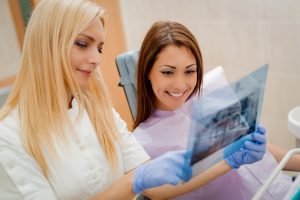 It is relatively normal, even during a routine cleaning, for your dentist to suggest you get dental X-rays.
It is relatively normal, even during a routine cleaning, for your dentist to suggest you get dental X-rays.
X-rays are a very common dental procedure that lets your dentist see deep beneath your gums, even into your bones, to the roots of your teeth, and through your tooth enamel.
But if you know anything about X-rays, you probably know they use radiation to achieve their results, and some people find this quite concerning.
In movies (Godzilla anyone?), media, and online, you see quite a great deal of content about the dangers of radiation.
So, you may be wondering if dental X-rays are safe? The short answer is, “Yes, dental X-rays are safe and often extremely beneficial for your oral health”.
As far as radiation is concerned, the amount to which you are exposed is minimal.
Dentists are quick to note that there are multiple sources of radiation in your daily life that expose you to higher levels, over a year, than a dental X-ray.
There are, however, some circumstances in which an X-ray is not recommended.
To make it all clear to you, Ria Family Dental will explain to you how much radiation is in an X-ray, who needs a dental X-ray, and who might not want to get a dental X-ray.
How much radiation is in an X-ray?
When X-rays were first introduced, dentists and other professional did not understand the danger of repeated radiation exposure, and proper safety features and procedures had not yet been developed.
However, as knowledge and technology have advanced, the amount of radiation used and possible patient exposure to it has decreased dramatically.
To put dental X-rays into perspective, let’s compare them to other environmental sources of radiation.
For perspective, a single digital dental X-ray has 0.1mrem of radiation, and a set of 4 bitewings has 0.4mrem.
Compare that to:
- Natural radiation from soil: 35mrem per year
- Smoking cigarettes: 1,300mrem per year
- Transcontinental flight: 2-4mrem
- Drinking water: 5mrem per year
- Using natural gas for heating and cooking: 9mrem per year
It’s pretty clear how low the level of radiation is, in a dental X-ray.
One aeroplane flight across the country gives you more radiation exposure than X-rays and eating ten bananas exposes you to as much radiation as one X-ray!
Basically, while dental X-rays expose you to some radiation, the benefits of having them performed outweigh the risks.
Many dental problems are invisible to the naked eye, and X-rays let your dentist discover a range of problems in tooth enamel, gums, and tooth roots.
Safety and X-rays
Dental X-ray tools and techniques have been honed over time to minimise the exposure to radiation.
Every protective tactic possible is taken to be sure that patients are safe. Lead aprons minimise exposure to the trunk of the body, and a leaded thyroid collar protects the thyroid.
These tools are particularly important in cases of patients who should be a bit more careful about X-rays, particularly pregnant women.
Who Needs a Dental X-Ray?
Many people might need a dental X-ray. Your dentist may need to diagnose a problem that’s causing pain or to determine the structure of your mouth in order to place dental work.
Several of the issues that can be discovered by an X-ray are far worse than the tiny amount of radiation involved.
Here are some problems that can be found using a dental X-ray:
- Decay between the teeth.
- Changes in a root canal.
- Bone loss.
- Tumours or growths.
- Infections between the tooth and gums.
These are the kind of problems that, without the use of dental X-rays, can develop silently and lead to far worse problems down the road.
When it comes to dental health, it’s always simpler, less expensive, and less painful to catch these issues early.
Who should NOT get X-rays?
Pregnant women. If you are pregnant, you should avoid X-rays until after birth. This is to protect the health of the foetus, which is much more susceptible to radiation problems than grown adults.
The speed at which a foetus changes at the cellular and DNA level makes X-rays particularly dangerous. You should have regular dental check-ups during pregnancy. Just make sure your Ria Family Dental dentist knows about your condition.
Children. This is an arguable one. There’s no such thing as a completely safe exposure level, and radiation is cumulative over your lifetime.
Children may be vulnerable since they’re small, and their cells are dividing rapidly. Discuss this with your dentist.
Your Dental Family in Yeronga
At Ria Family Dental in Yeronga, we give comprehensive care that addresses short and long-term dental care needs. We provide an honest, judgment-free environment in which we practice convenient, comfortable, and conservative care.
Our offices are at 1/451B Fairfield Rd, with Yeronga station and bus stops nearby, as well convenient storefront parking. For the convenience of our patients, we offer early evening hours on most weeknights.
Yeronga dentist also serves the local communities in Yeerongpilly, Annerley, Tarragindi, Rocklea, Fairfield, Tennyson, Graceville, Chelmer and Moorooka.
For more information, give us a call on 0451 359 356 or use our online booking service here!
We are located at 1/451B Fairfield Rd in Yeronga.

